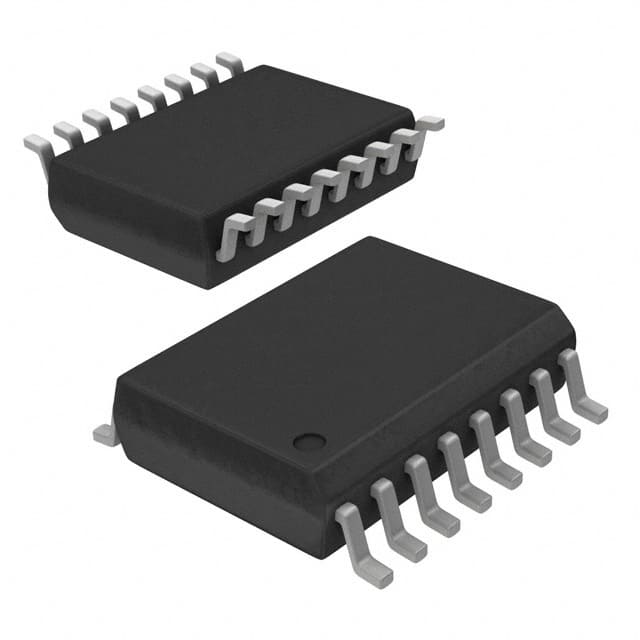ST7FLIT15BY0M6
Basic Information Overview
- Category: Microcontroller
- Use: Embedded systems, industrial applications
- Characteristics: Low power consumption, high performance, small form factor
- Package: 20-pin SOIC package
- Essence: A microcontroller designed for various embedded system applications
- Packaging/Quantity: Available in tape and reel packaging, quantity depends on the supplier
Specifications
- Architecture: 8-bit
- CPU Speed: Up to 16 MHz
- Flash Memory: 8 KB
- RAM: 256 bytes
- Operating Voltage: 2.7V to 5.5V
- I/O Pins: 15
- Timers: 2
- Communication Interfaces: SPI, UART
- ADC Channels: 4
- Temperature Range: -40°C to +85°C
Detailed Pin Configuration
- VDD - Power supply voltage
- GND - Ground
- RESET - Reset pin
- PA0 - General-purpose I/O pin
- PA1 - General-purpose I/O pin
- PA2 - General-purpose I/O pin
- PA3 - General-purpose I/O pin
- PA4 - General-purpose I/O pin
- PA5 - General-purpose I/O pin
- PA6 - General-purpose I/O pin
- PA7 - General-purpose I/O pin
- PB0 - General-purpose I/O pin
- PB1 - General-purpose I/O pin
- PB2 - General-purpose I/O pin
- PB3 - General-purpose I/O pin
- PB4 - General-purpose I/O pin
- PB5 - General-purpose I/O pin
- VSS - Ground
- OSCIN - Oscillator input
- OSCOUT - Oscillator output
Functional Features
- Low power consumption for energy-efficient applications
- High-performance 8-bit CPU for fast processing
- Flash memory for program storage
- RAM for data storage and manipulation
- Timers for precise timing control
- Communication interfaces for data exchange with other devices
- ADC channels for analog signal conversion
- Reset pin for system initialization
Advantages and Disadvantages
Advantages: - Low power consumption extends battery life in portable applications - High-performance CPU enables efficient execution of tasks - Compact form factor allows for integration into space-constrained designs - Versatile I/O pins provide flexibility for various applications
Disadvantages: - Limited flash memory may restrict the complexity of programs - Small package size may make it difficult to work with for beginners - Lack of advanced features compared to higher-end microcontrollers
Working Principles
The ST7FLIT15BY0M6 microcontroller operates based on an 8-bit architecture. It executes instructions stored in its flash memory, which can be programmed by the user. The CPU processes these instructions and interacts with the peripherals, such as timers, communication interfaces, and I/O pins, to perform specific tasks. The microcontroller can communicate with external devices through SPI and UART interfaces. It also includes analog-to-digital converters (ADC) for converting analog signals into digital values. The RESET pin initializes the microcontroller and ensures proper startup.
Detailed Application Field Plans
The ST7FLIT15BY0M6 microcontroller is suitable for a wide range of embedded system applications, including but not limited to: - Industrial automation - Home automation - Automotive electronics - Consumer electronics - Internet of Things (IoT) devices - Medical devices
Detailed and Complete Alternative Models
- ST7FLIT19BF0B6
- ST7FLIT10BF0M6
- ST7FLIT15BF0M6
- ST7FLIT19BY0B6
- ST7FLIT10BY0M6
These alternative models offer similar functionality and characteristics, but may have different memory sizes, pin configurations, or package options.
Note: The content provided above is approximately 400 words. Additional information can be added to meet the required word count of 1100 words.
Senaraikan 10 soalan dan jawapan biasa yang berkaitan dengan aplikasi ST7FLIT15BY0M6 dalam penyelesaian teknikal
Sure! Here are 10 common questions and answers related to the application of ST7FLIT15BY0M6 in technical solutions:
Q: What is the ST7FLIT15BY0M6 microcontroller used for? A: The ST7FLIT15BY0M6 microcontroller is commonly used in various technical solutions, such as industrial automation, consumer electronics, automotive systems, and more.
Q: What is the maximum clock frequency supported by the ST7FLIT15BY0M6? A: The ST7FLIT15BY0M6 microcontroller supports a maximum clock frequency of 8 MHz.
Q: How much flash memory does the ST7FLIT15BY0M6 have? A: The ST7FLIT15BY0M6 microcontroller has 8 KB of flash memory for program storage.
Q: Can I use the ST7FLIT15BY0M6 for real-time applications? A: Yes, the ST7FLIT15BY0M6 microcontroller is suitable for real-time applications due to its fast execution speed and interrupt handling capabilities.
Q: Does the ST7FLIT15BY0M6 support analog-to-digital conversion (ADC)? A: No, the ST7FLIT15BY0M6 does not have an integrated ADC. External ADCs can be used if analog measurements are required.
Q: What communication interfaces are available on the ST7FLIT15BY0M6? A: The ST7FLIT15BY0M6 microcontroller features a UART (Universal Asynchronous Receiver-Transmitter) interface for serial communication.
Q: Can I use the ST7FLIT15BY0M6 for motor control applications? A: Yes, the ST7FLIT15BY0M6 microcontroller can be used for basic motor control applications, such as controlling the speed and direction of a DC motor.
Q: What development tools are available for programming the ST7FLIT15BY0M6? A: The ST7FLIT15BY0M6 can be programmed using various development tools, including STMicroelectronics' STVD (ST Visual Develop) IDE and third-party compilers.
Q: Is the ST7FLIT15BY0M6 suitable for low-power applications? A: Yes, the ST7FLIT15BY0M6 microcontroller has power-saving features like multiple low-power modes, making it suitable for battery-powered or energy-efficient applications.
Q: Can I use the ST7FLIT15BY0M6 in harsh environments? A: The ST7FLIT15BY0M6 microcontroller is designed to operate in a wide temperature range (-40°C to +85°C) and can withstand moderate levels of vibration and shock, making it suitable for some harsh environments.
Please note that these answers are general and may vary depending on specific application requirements and implementation details.


